Abstract
Forty women took part in a study to determine the effects of high-intensity training and the menstrual cycle on mood states. Half of the sample were competitive distance runners following a training load of between 50 km and 130 km running per week. Seven athletes were amenorrhoeic and 13 either eumenorrhoeic or oligomenorrhoeic. The remaining 20 subjects were inactive women who menstruated regularly. The mean age of all 40 subjects was 29 years. Each subject completed two identical Profile of Mood States (POMS) questionnaires. The 33 menstruating subjects completed both a premenstrual and a midcycle form and the amenorrhoeic athletes completed the questionnaires at a 3-week interval, which acted as a control for the potential effects of premenstrual syndrome (PMS) among the menstruating females. Results showed highly significant differences in mood profiles among amenorrhoeic athletes, non-amenorrhoeic athletes and inactive women. The greatest difference was between premenstrual and midcycle measures for the inactive group. PMS appears to cause marked negative mood swings among menstruating women which the POMS inventory is sensitive in detecting. While the lower-intensity-training runners appeared to benefit psychologically from a training distance of approximately 50 km week-1, high-intensity training had an adverse effect on mood.
Full text
PDF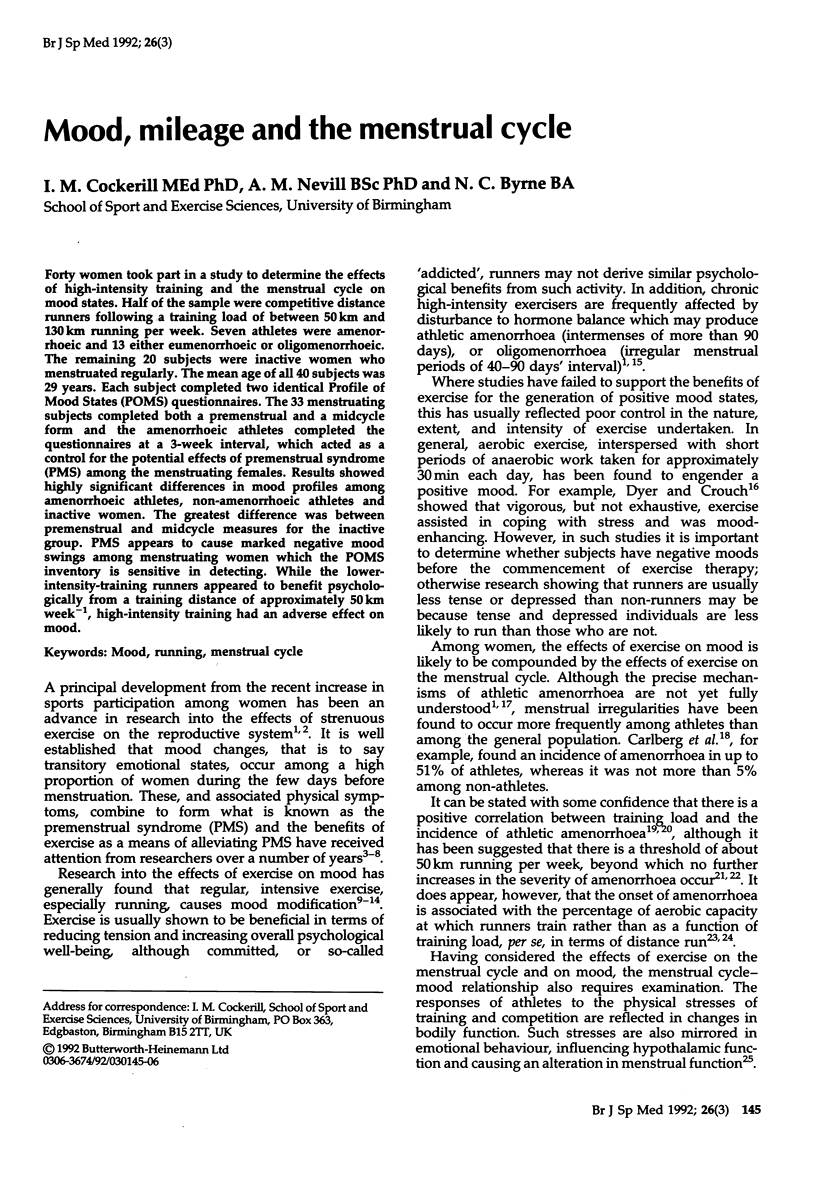
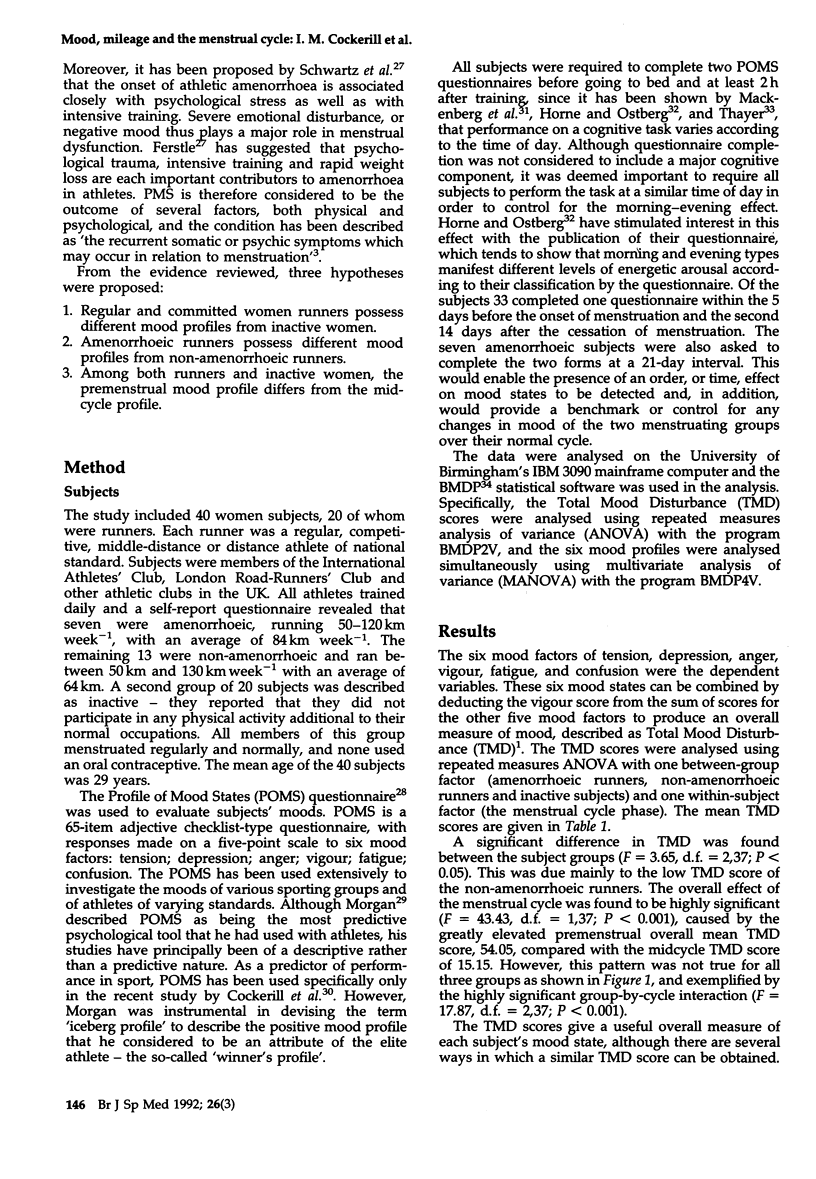
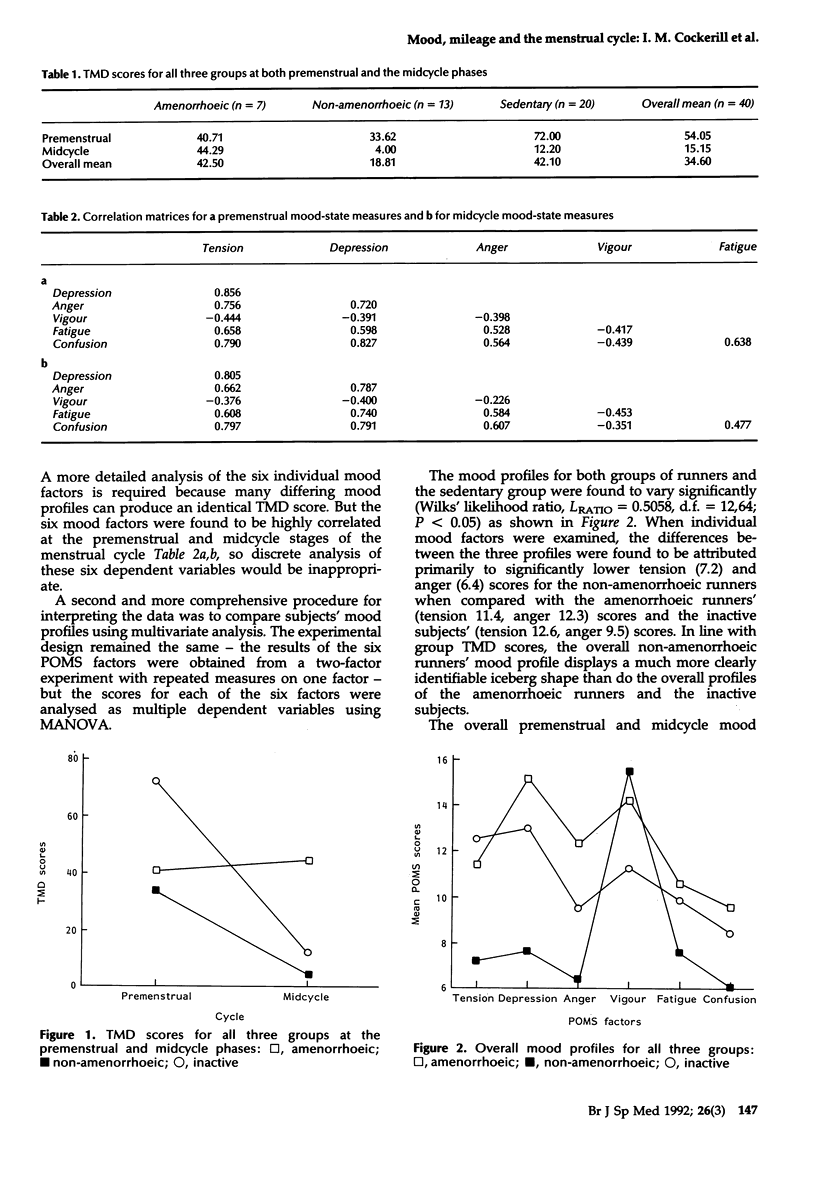
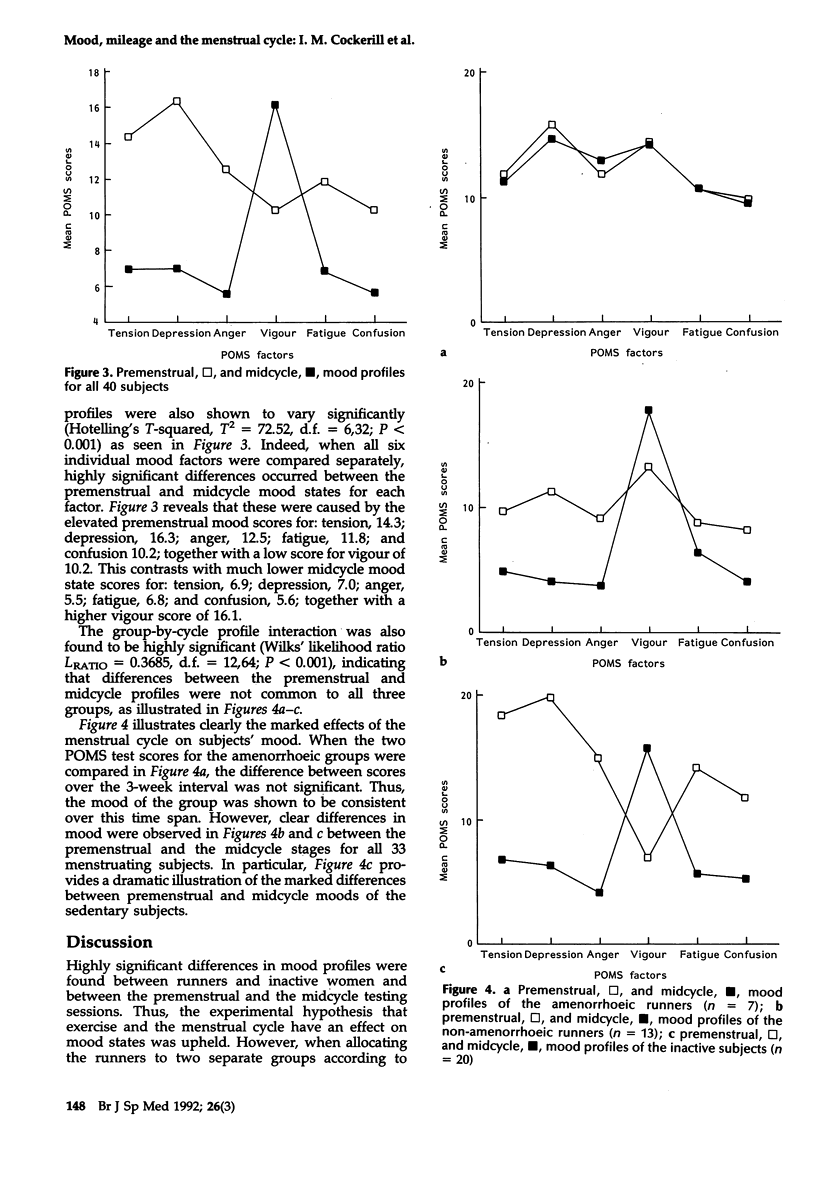
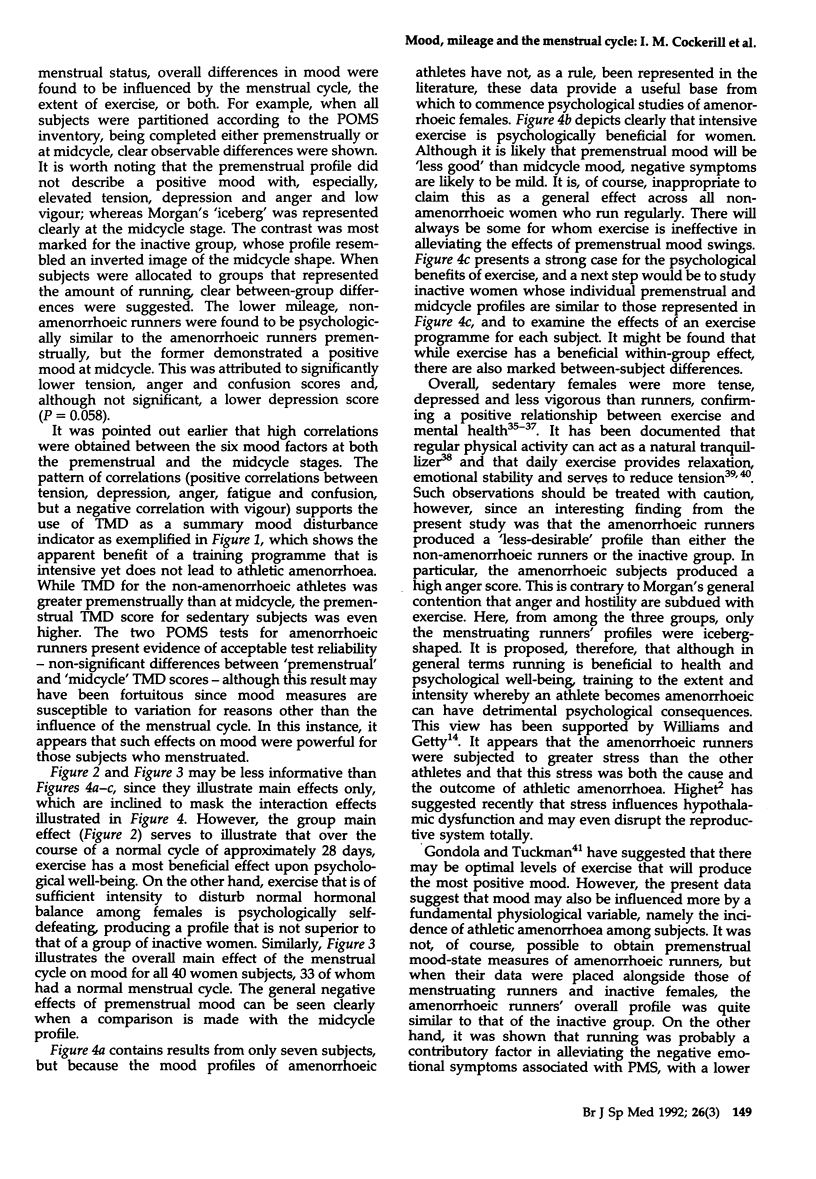
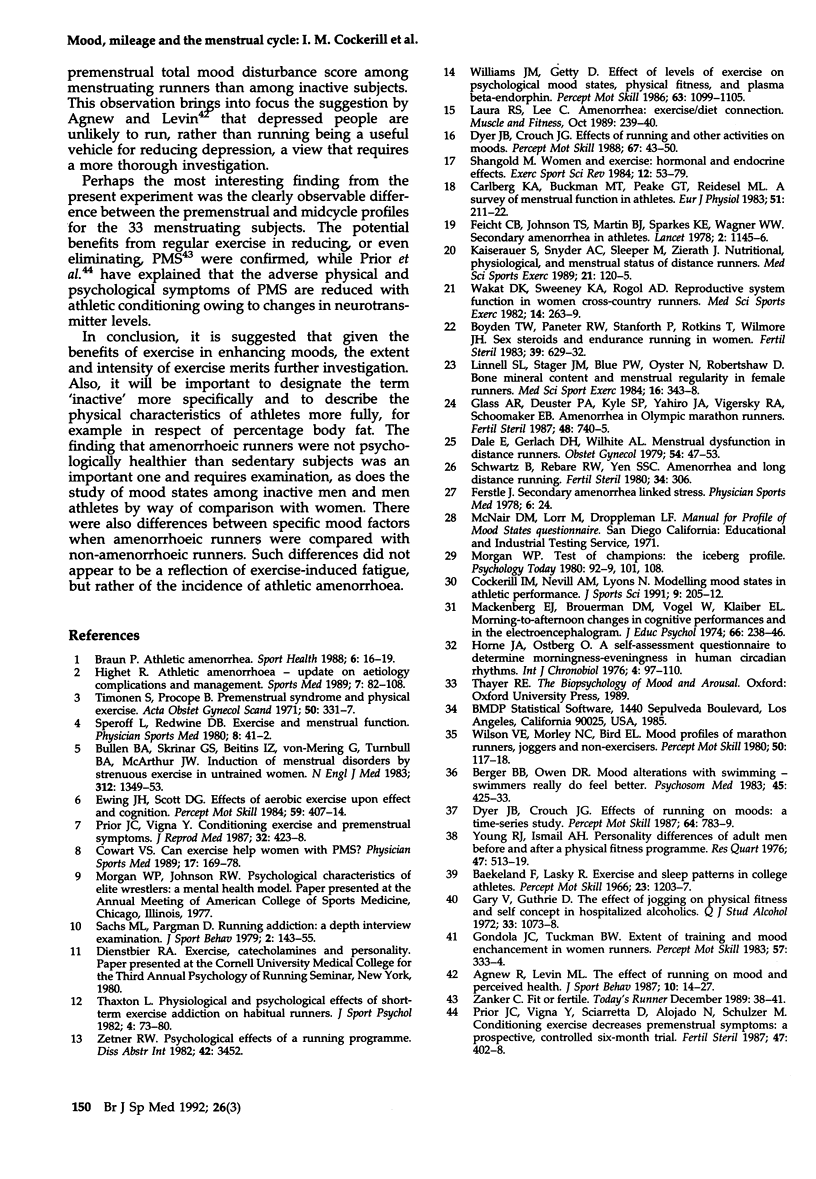
Selected References
These references are in PubMed. This may not be the complete list of references from this article.
- Baekeland F., Lasky R. Exercise and sleep patterns in college athletes. Percept Mot Skills. 1966 Dec;23(3):1203–1207. doi: 10.2466/pms.1966.23.3f.1203. [DOI] [PubMed] [Google Scholar]
- Berger B. G., Owen D. R. Mood alteration with swimming--swimmers really do "feel better". Psychosom Med. 1983 Oct;45(5):425–433. doi: 10.1097/00006842-198310000-00006. [DOI] [PubMed] [Google Scholar]
- Boyden T. W., Pamenter R. W., Stanforth P., Rotkis T., Wilmore J. H. Sex steroids and endurance running in women. Fertil Steril. 1983 May;39(5):629–632. doi: 10.1016/s0015-0282(16)47057-3. [DOI] [PubMed] [Google Scholar]
- Bullen B. A., Skrinar G. S., Beitins I. Z., von Mering G., Turnbull B. A., McArthur J. W. Induction of menstrual disorders by strenuous exercise in untrained women. N Engl J Med. 1985 May 23;312(21):1349–1353. doi: 10.1056/NEJM198505233122103. [DOI] [PubMed] [Google Scholar]
- Cockerill I. M., Nevill A. M., Lyons N. Modelling mood states in athletic performance. J Sports Sci. 1991 Summer;9(2):205–212. doi: 10.1080/02640419108729881. [DOI] [PubMed] [Google Scholar]
- Dale E., Gerlach D. H., Wilhite A. L. Menstrual dysfunction in distance runners. Obstet Gynecol. 1979 Jul;54(1):47–53. doi: 10.1097/00006250-197907000-00013. [DOI] [PubMed] [Google Scholar]
- Dyer J. B., 3rd, Crouch J. G. Effects of running and other activities on moods. Percept Mot Skills. 1988 Aug;67(1):43–50. doi: 10.2466/pms.1988.67.1.43. [DOI] [PubMed] [Google Scholar]
- Feicht C. B., Johnson T. S., Martin B. J., Sparkes K. E., Wagner W. W., Jr Secondary amenorrhoea in athletes. Lancet. 1978 Nov 25;2(8100):1145–1146. doi: 10.1016/s0140-6736(78)92294-8. [DOI] [PubMed] [Google Scholar]
- Gary V., Guthrie D. The effect of jogging on physical fitness and self-concept in hospitalized alcoholics. Q J Stud Alcohol. 1972 Dec;33(4):1073–1078. [PubMed] [Google Scholar]
- Glass A. R., Deuster P. A., Kyle S. B., Yahiro J. A., Vigersky R. A., Schoomaker E. B. Amenorrhea in Olympic marathon runners. Fertil Steril. 1987 Nov;48(5):740–745. [PubMed] [Google Scholar]
- Highet R. Athletic amenorrhoea. An update on aetiology, complications and management. Sports Med. 1989 Feb;7(2):82–108. doi: 10.2165/00007256-198907020-00002. [DOI] [PubMed] [Google Scholar]
- Horne J. A., Ostberg O. A self-assessment questionnaire to determine morningness-eveningness in human circadian rhythms. Int J Chronobiol. 1976;4(2):97–110. [PubMed] [Google Scholar]
- Kaiserauer S., Snyder A. C., Sleeper M., Zierath J. Nutritional, physiological, and menstrual status of distance runners. Med Sci Sports Exerc. 1989 Apr;21(2):120–125. [PubMed] [Google Scholar]
- Linnell S. L., Stager J. M., Blue P. W., Oyster N., Robertshaw D. Bone mineral content and menstrual regularity in female runners. Med Sci Sports Exerc. 1984 Aug;16(4):343–348. [PubMed] [Google Scholar]
- Mackenberg E. J., Broverman D. M., Vogel W., Klaiber E. L. Morning-to-afternoon changes in cognitive performances and in the electroencephalogram. J Educ Psychol. 1974 Apr;66(2):238–246. doi: 10.1037/h0036131. [DOI] [PubMed] [Google Scholar]
- Prior J. C., Vigna Y. Conditioning exercise and premenstrual symptoms. J Reprod Med. 1987 Jun;32(6):423–428. [PubMed] [Google Scholar]
- Prior J. C., Vigna Y., Sciarretta D., Alojado N., Schulzer M. Conditioning exercise decreases premenstrual symptoms: a prospective, controlled 6-month trial. Fertil Steril. 1987 Mar;47(3):402–408. doi: 10.1016/s0015-0282(16)59045-1. [DOI] [PubMed] [Google Scholar]
- Shangold M. M. Exercise and the adult female: hormonal and endocrine effects. Exerc Sport Sci Rev. 1984;12:53–79. [PubMed] [Google Scholar]
- Timonen S., Procopé B. J. Premenstrual syndrome and physical exercise. Acta Obstet Gynecol Scand. 1971;50(4):331–337. doi: 10.3109/00016347109157334. [DOI] [PubMed] [Google Scholar]
- Wakat D. K., Sweeney K. A., Rogol A. D. Reproductive system function in women cross-country runners. Med Sci Sports Exerc. 1982;14(4):263–269. doi: 10.1249/00005768-198204000-00002. [DOI] [PubMed] [Google Scholar]
- Williams J. M., Getty D. Effect of levels of exercise on psychological mood states, physical fitness, and plasma beta-endorphin. Percept Mot Skills. 1986 Dec;63(3):1099–1105. doi: 10.2466/pms.1986.63.3.1099. [DOI] [PubMed] [Google Scholar]
- Wilson V. E., Morley N. C., Bird E. I. Mood profiles of marathon runners, joggers and non-exercisers. Percept Mot Skills. 1980 Feb;50(1):117–118. doi: 10.2466/pms.1980.50.1.117. [DOI] [PubMed] [Google Scholar]
- Young R. J., Ismail A. H. Personality differences of adult men before and after a physical fitness program. Res Q. 1976 Oct;47(3):513–519. [PubMed] [Google Scholar]


